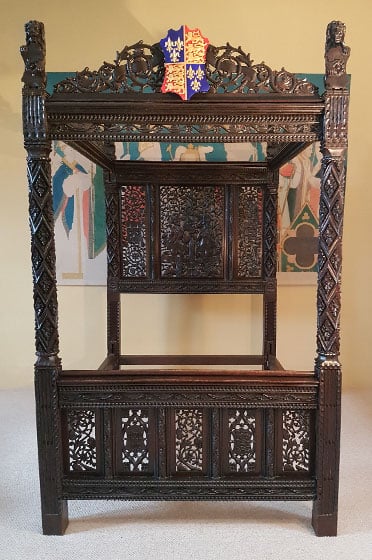Art World
An Antiques Dealer Thinks He Found the Bed Where King Henry VIII Was Conceived. It Was Hiding in Plain Sight in an English Hotel Room
The dealer picked up the bed at an English auction in 2010 for £2,200.

The dealer picked up the bed at an English auction in 2010 for £2,200.

Henri Neuendorf

An intricately carved and decorated oak four-poster bed that spent more than 15 years furnishing the honeymoon suite of a British hotel may have belonged to King Henry VII and Elizabeth of York, the founders of the House of Tudor—and it may be where their infamous son, Henry VIII, was conceived.
The bed was saved from a scrapheap in 2010 by an antiques dealer who consigned it to a Chester-based auction house, where it was listed as a “profusely carved Victorian four poster bed with armorial shields,” according to Smithsonian Magazine.
But Ian Coulson, who bought the piece for £2,200, recognized that the bed showed signs of extensive restoration, which would have been unusual for such a recent piece of furniture. He also noticed that markings on the frame suggested it was hand-carved and not manufactured with a mechanized saw.
Coulson then spent the next nine years researching the bed, which is rich in Tudor iconography and includes depictions of red and white roses, which stood, respectively, for the houses of Lancaster and and York. The houses were united through the marriage of Henry and Elizabeth. The fact that the roses are depicted separately, and not as the unified Tudor rose, may be because the unified iconography of the new house had not yet been developed.
Fertility symbols, such as depictions of Adam and Even in the headboard’s central panel, support the likelihood that the bed was made shortly after the couple’s union, when there was an urgent need to secure the house’s dynasty through the birth of a male heir. Further forensic evidence has revealed traces of ultramarine paint, an expensive pigment more costly that gold in 15th-century England, which means the bed likely belonged to someone of enormous means.
Coulson presented his findings in January at a symposium at the Victoria & Albert Museum. His presentation was first reported by Live Science.
According to Smithsonian Magazine, if Coulson’s hypothesis is correct, the bed would be one of the few pieces of furniture belonging to the couple still in existence, as most furnishings from the Tudor dynasty were destroyed by anti-monarchy Parliamentarians during the English Civil War from 1642–51.